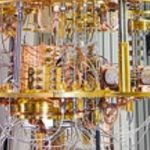What’s Under the Hood of A Quantum Computer?
(PhysicsToday) The separation between hardware and user interface is the product of decades of development. Now quantum computer developers are navigating similar terrain.
The quantum computing stack is everything that lies between a user and the physical qubits. The stack needs to perform essential functions; for instance, it must facilitate user interaction, turn inputs into hardware manipulation, and correct for numerous error sources.
There’s no one right way to divide those tasks into discrete levels, though, and researchers and technology companies are still pursuing different visions for future quantum architectures.
Harrison Ball, Michael Biercuk, and Michael Hush present the quantum computing stack proposed by Q-CTRL in this articl
NOTE: The following is a summary by IQT-News’ of this article’s description of each of the key components of a quantum computer. The summary and the original article are both worth the time to read. Additional sources are provided in the original article as well for indepth followup.
Qubit hardware:
Classical computers store information as bits that each take a value of 0 or 1. Underlying those bits are field-effect transistors that act as switches; each can take a value of either 0 or 1 depending on whether the switch is on or off. At the most basic level, everything a computer does—save information, execute calculations, run programs—is just manipulating the values of those billions of bits with small electrical voltages.
Quantum computers instead rely on qubits that can be in one of two states, ∣0〉 or ∣1〉, or a linear superposition.
Whereas classical computing has largely settled on one type of bit hardware, qubits still come in many varieties. Any two-level quantum system—a nuclear spin, a photon’s polarization, or a quantum dot’s spin, to name a few—can be used as a qubit. The usefulness of a particular system, however, depends on things such as how easily the qubits are to manipulate and entangle, how long they remain in desired quantum states, and how prone they are to having their states destroyed by outside noise.
Quantum firmware
Qubits are prone to errors. All sorts of environmental factors—thermal fluctuations, electromagnetic radiation, magnetic fields—can knock a qubit out of its intended state. That degradation of information is known as decoherence and can occur in a fraction of a second. Despite the use of refrigeration to reduce thermal fluctuations, decoherence eventually creeps in and produces hardware errors, like accidentally flipping a qubit’s state from ∣0〉 to ∣1〉. (The commonly used refrigeration systems, like the one shown above from IBM, are what many people picture when they imagine a quantum computer.) The number of operations that can be performed with a qubit is limited by the qubit’s decoherence time. Moreover, every set of qubit hardware has its own unique deviations from ideal performance.
Hardware-aware quantum compiler
The hardware-aware quantum compiler, also known as a transpiler, is responsible for figuring out how to complete a set of logic operations in a manner that accounts for the physical connections between qubits. Although physical qubits can’t easily be moved, the states of two qubits can be swapped for an effective rearrangement. The transpiler works out how to implement an arbitrary operation between qubits given the hardware constraints, such as which qubits are directly connected to each other. It also decides which qubits to use for each operation—for instance, if a particular qubit is known to be faulty, information might need to be routed around it.
Quantum Error Corrector
Correcting qubit errors with QEC is inherently resource intensive—some current schemes use tens of physical qubits per logical block—and will likely require more qubits than are available in existing devices to provide any real benefit. Accordingly, QEC is more important in the long term than it is for current machines. Quantum firmware aims to reduce the burden on QEC routines by dealing with more predictable noise, thereby improving QEC’s resource efficiency.
Logical-level compilation and circuit optimization
A single algorithm can be represented by multiple logically equivalent circuits, and the goal of circuit optimization is to find the one requiring the fewest operations or timesteps. Executing fewer operations enables the algorithm to run faster—an important goal for any quantum computer, whether or not it is using QEC.
Quantum algorithms and applications
Quantum algorithms play the same role as classical algorithms: They provide step-by-step instructions for completing a computational task. Although a regular algorithm could in principle be run on a quantum computer, a true quantum algorithm takes advantage of the underlying hardware’s quantum nature.
A variational quantum algorithm is a compromise between classical and quantum ones. It breaks up a computation into a small quantum component and a larger classical optimization problem and therefore requires a much smaller quantum computer than, say, the quantum Fourier transform. Such algorithms are promising for solving problems in finance, logistics, and chemistry.
User interface, QAAS, and operating system
Most people who want to use quantum computers aren’t going to build or even buy one—at least not anytime soon. To facilitate access to the limited existing quantum computing resources, companies have put together cloud-based infrastructures that allow remote operation. As in a classical computer, the highest level of the quantum computing stack provides the interface that users interact with.



















